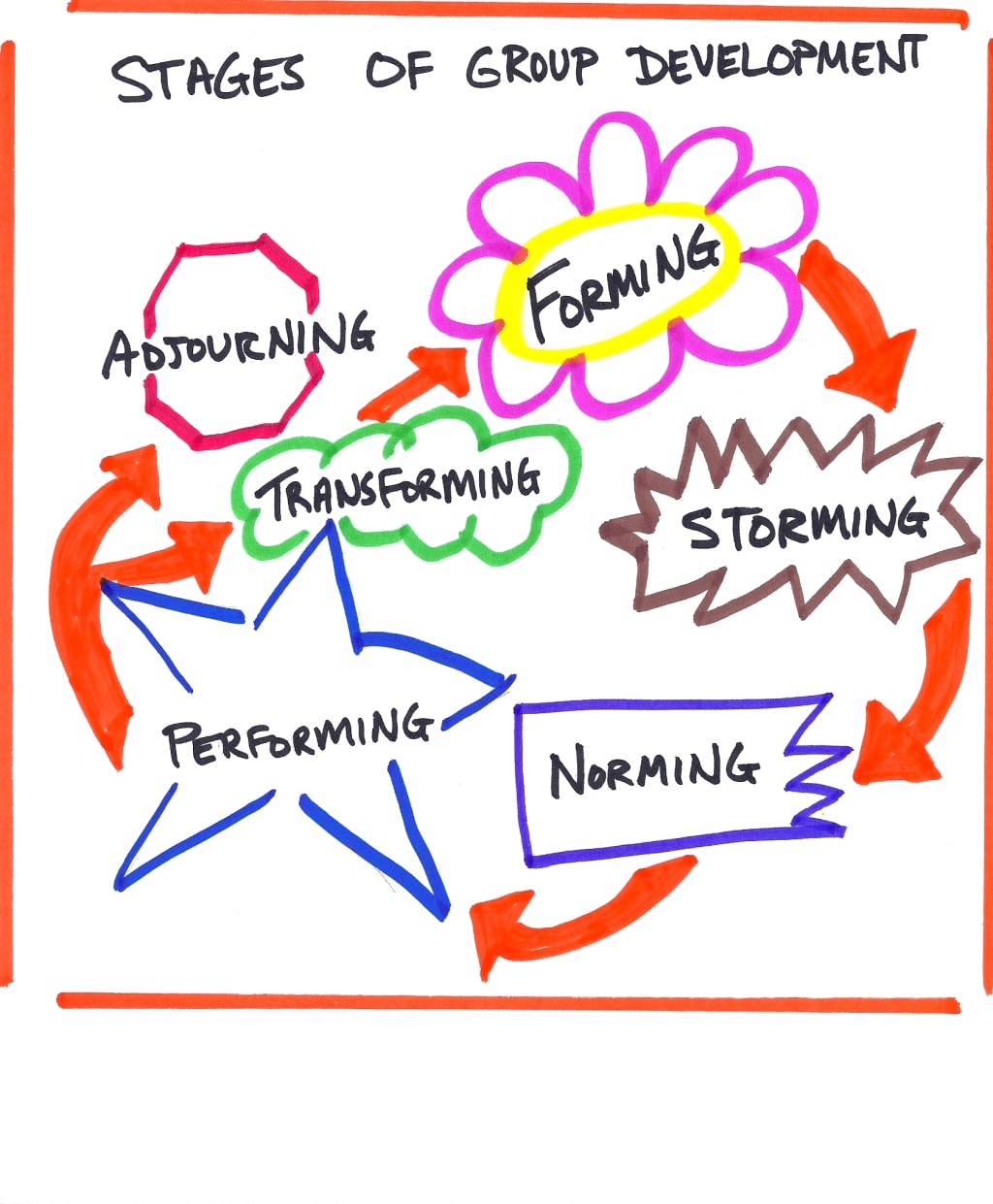You're One of My Kind
Staying Connected to Your Team

I got a text message from someone addressed to her 'Favorite Training Person.'
For a time I was a trainer for Waldenbooks/Borders Group. It was just about the most useful and fulfilled that I have ever felt in a job.
I got to do one-on-one training with new managers in my base store, and then group training with amazingly talented trainers in an offsite location.
We worked first on flip charts (yup!) then graduated to PowerPoint. Soft skills were part of the group training: recruiting, conflict management, communication... and change.
She was asking if I remembered the stages a high-performing team goes through when change is introduced, something about 'storming'. Oh yes. Yes, I remember.
It was introduced by Bruce W. Tuckman, and was just MADE for flip charts and PowerPoint. (Lots of fun to use the Human Bean images from old-school Office for the slides)
The idea is that a team doing well falters harder than a less-well performing team when a change is introduced but they rebound higher once the change is integrated. I sent her some texts with the info, and smiled that she had asked me.
(When you are part of my team you stay part of my team, lifetime consulting just goes along with it.
That, and I was glad to hear from her, since she has always been dear to my heart.
Some people you hire, some you inherit, and if you are lucky some become family no matter how they enter your life.
It's just: I think Bruce missed a stage.
For one thing- not every team IS a high-performing team when change comes a-knockin'. Some teams never make it to levels where anything is delivered, where they can function together at all.
And some teams need another stage in there somewhere: Mourning.
(Maybe he would have added it if it was spelled 'Mourming'?)
Change is the cessation of what was and a path to what will be. It's the death of the old way that gives way to the new. And that death may need some time to sink in, to process. I think that some of the Storming Mr. Bruce noted was actually Mourning.
And you know, sad people just aren't always that interested in getting things done. Sometimes they can't think past what they used to do, what they lost, what WAS- even if they didn't like the way it was before all that much. It was familiar.
They could do it with their eyes closed. It had been GOOD ENOUGH (dammit!), there wasn't that much of a reason to do it a new way!
Sometimes Anger is Sadness being all noisy and gesturing and frustrated.
So I've been thinking the past few days about Change. About the things that I've had to let go before I was ready to do so. About the people that have left my life even though I wanted them to stay. About places I thought I would see again but must now face up to never revisiting. About time that I wanted to myself that now has competing demands from others.
About times when I knew ALL the old ways to do the old things and the Mourning when that all stopped. About how Mourning is part of the process, but it isn't the END of the process. About how I now am getting so much better at knowing the new ways to do the new things.
And about teams.
Change happens all of the time. And for many companies the change is frightening. The uncertainty of 'will this work at all?' is often infused with the change.
And maybe the answer is 'we don't know-but we need to try something.'
So change requires a leap of faith. Even if that leap is terrifying. Even if that leap isn't what you wanted. Even if you had been OK with things-just-as-they-were.
Change is leaving the old ways for the vision of the new. Change is the Storming/Mourning/Anger/Sadness/Jump into the future.
The past year has rocked many teams through changing processes and expectations. Some people thrived on learning new things, some quit in frustration because the change was just too much to ask. The leaders of teams need to set the pace- need to be honest about their own struggles- so that other people feel safe to share their place in the process, too.
There's another part of the process, a part for temporary teams. Once they complete their purpose the enter the Adjourning phase. Everyone takes their learnings (ugh! to corp-speak!) and the team disbands. I'm glad that's not what has happened to many of my teams. True; we no longer work together... but we are still connected.
Staying connected can take some work-but it's worth it. Even with social distancing, and maybe BECAUSE of social distancing! we can use technology to stay in touch. To share information, comment on life events, rejoice and congratulate on milestones achieved.
It's more than networking. It's being involved and engaged.
I got the text the other day because she knows I'm still part of her team, albeit several hundred miles and many companies removed from when we worked together. But we are still a team.
She's one of my kind.
About the Creator
Judey Kalchik
It's my time to find and use my voice.
Poetry, short stories, memories, and a lot of things I think and wish I'd known a long time ago.
You can also find me on Medium
And please follow me on Threads, too!






Comments (1)
My ex-husband and his wife talk about this a lot, how they still have friends and colleagues that feel like a team even after leaving a company!